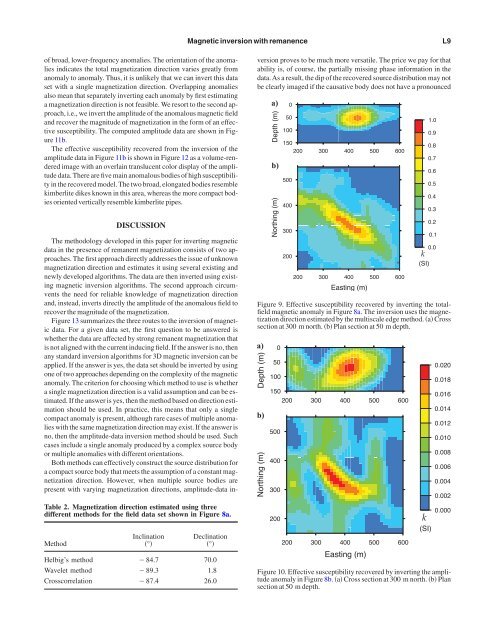Comprehensive approaches to 3D inversion of magnetic ... - CGISS
Comprehensive approaches to 3D inversion of magnetic ... - CGISS
Comprehensive approaches to 3D inversion of magnetic ... - CGISS
You also want an ePaper? Increase the reach of your titles
YUMPU automatically turns print PDFs into web optimized ePapers that Google loves.
Magnetic <strong>inversion</strong> with remanence<br />
L9<br />
<strong>of</strong> broad, lower-frequency anomalies. The orientation <strong>of</strong> the anomalies<br />
indicates the <strong>to</strong>tal magnetization direction varies greatly from<br />
anomaly <strong>to</strong> anomaly. Thus, it is unlikely that we can invert this data<br />
set with a single magnetization direction. Overlapping anomalies<br />
also mean that separately inverting each anomaly by first estimating<br />
a magnetization direction is not feasible. We resort <strong>to</strong> the second approach,<br />
i.e., we invert the amplitude <strong>of</strong> the anomalous <strong>magnetic</strong> field<br />
and recover the magnitude <strong>of</strong> magnetization in the form <strong>of</strong> an effective<br />
susceptibility. The computed amplitude data are shown in Figure<br />
11b.<br />
The effective susceptibility recovered from the <strong>inversion</strong> <strong>of</strong> the<br />
amplitude data in Figure 11b is shown in Figure 12 as a volume-rendered<br />
image with an overlain translucent color display <strong>of</strong> the amplitude<br />
data. There are five main anomalous bodies <strong>of</strong> high susceptibility<br />
in the recovered model. The two broad, elongated bodies resemble<br />
kimberlite dikes known in this area, whereas the more compact bodies<br />
oriented vertically resemble kimberlite pipes.<br />
DISCUSSION<br />
Table 2. Magnetization direction estimated using three<br />
different methods for the field data set shown in Figure 8a.<br />
Method<br />
Inclination<br />
°<br />
Declination<br />
°<br />
Helbig’s method 84.7 70.0<br />
Wavelet method 89.3 1.8<br />
Crosscorrelation 87.4 26.0<br />
The methodology developed in this paper for inverting <strong>magnetic</strong><br />
data in the presence <strong>of</strong> remanent magnetization consists <strong>of</strong> two <strong>approaches</strong>.<br />
The first approach directly addresses the issue <strong>of</strong> unknown<br />
magnetization direction and estimates it using several existing and<br />
newly developed algorithms. The data are then inverted using existing<br />
<strong>magnetic</strong> <strong>inversion</strong> algorithms. The second approach circumvents<br />
the need for reliable knowledge <strong>of</strong> magnetization direction<br />
and, instead, inverts directly the amplitude <strong>of</strong> the anomalous field <strong>to</strong><br />
recover the magnitude <strong>of</strong> the magnetization.<br />
Figure 13 summarizes the three routes <strong>to</strong> the <strong>inversion</strong> <strong>of</strong> <strong>magnetic</strong><br />
data. For a given data set, the first question <strong>to</strong> be answered is<br />
whether the data are affected by strong remanent magnetization that<br />
is not aligned with the current inducing field. If the answer is no, then<br />
any standard <strong>inversion</strong> algorithms for <strong>3D</strong> <strong>magnetic</strong> <strong>inversion</strong> can be<br />
applied. If the answer is yes, the data set should be inverted by using<br />
one <strong>of</strong> two <strong>approaches</strong> depending on the complexity <strong>of</strong> the <strong>magnetic</strong><br />
anomaly. The criterion for choosing which method <strong>to</strong> use is whether<br />
a single magnetization direction is a valid assumption and can be estimated.<br />
If the answer is yes, then the method based on direction estimation<br />
should be used. In practice, this means that only a single<br />
compact anomaly is present, although rare cases <strong>of</strong> multiple anomalies<br />
with the same magnetization direction may exist. If the answer is<br />
no, then the amplitude-data <strong>inversion</strong> method should be used. Such<br />
cases include a single anomaly produced by a complex source body<br />
or multiple anomalies with different orientations.<br />
Both methods can effectively construct the source distribution for<br />
a compact source body that meets the assumption <strong>of</strong> a constant magnetization<br />
direction. However, when multiple source bodies are<br />
present with varying magnetization directions, amplitude-data <strong>inversion</strong><br />
proves <strong>to</strong> be much more versatile. The price we pay for that<br />
ability is, <strong>of</strong> course, the partially missing phase information in the<br />
data.As a result, the dip <strong>of</strong> the recovered source distribution may not<br />
be clearly imaged if the causative body does not have a pronounced<br />
a)<br />
Depth (m)<br />
b)<br />
Northing (m)<br />
0<br />
50<br />
100<br />
150<br />
200 300 400 500 600<br />
500<br />
400<br />
300<br />
200<br />
200 300 400 500 600<br />
Easting (m)<br />
1.0<br />
0.9<br />
0.8<br />
0.7<br />
0.6<br />
0.5<br />
0.4<br />
0.3<br />
0.2<br />
0.1<br />
0.0<br />
k<br />
(SI)<br />
Figure 9. Effective susceptibility recovered by inverting the <strong>to</strong>talfield<br />
<strong>magnetic</strong> anomaly in Figure 8a. The <strong>inversion</strong> uses the magnetization<br />
direction estimated by the multiscale edge method. a Cross<br />
section at 300 m north. b Plan section at 50 m depth.<br />
a)<br />
Depth (m)<br />
b)<br />
Northing (m)<br />
0<br />
50<br />
100<br />
150<br />
200 300 400 500 600<br />
500<br />
400<br />
300<br />
200<br />
200 300 400 500 600<br />
Easting (m)<br />
k<br />
(SI)<br />
0.020<br />
0.018<br />
0.016<br />
0.014<br />
0.012<br />
0.010<br />
0.008<br />
0.006<br />
0.004<br />
0.002<br />
0.000<br />
Figure 10. Effective susceptibility recovered by inverting the amplitude<br />
anomaly in Figure 8b. a Cross section at 300 m north. b Plan<br />
section at 50 m depth.
















